IT Security Management Report: Cyber Attacks and Bank Security
VerifiedAdded on 2022/08/14
|28
|7232
|15
Report
AI Summary
This IT Security Management report, crafted for the COM7006 module at Arden University, delves into the critical aspects of cybersecurity within the banking sector. The report begins by outlining essential security policies, emphasizing the role of companies like Cow Brown Technology in advising financial institutions. It examines policies regarding data storage, electronic communication, data deletion, and network access, alongside the consequences of policy violations. The report then addresses security awareness, detailing the importance of continued education, effective communication, and formal training to combat cyber threats. It further explores access control mechanisms, including information limitation and virtual disk images, designed to safeguard sensitive data. Finally, the report analyzes the impact of cyber attacks on banking systems, providing an executive summary of the key challenges and mitigation strategies. This comprehensive analysis underscores the need for robust security measures to protect financial institutions from evolving cyber threats.
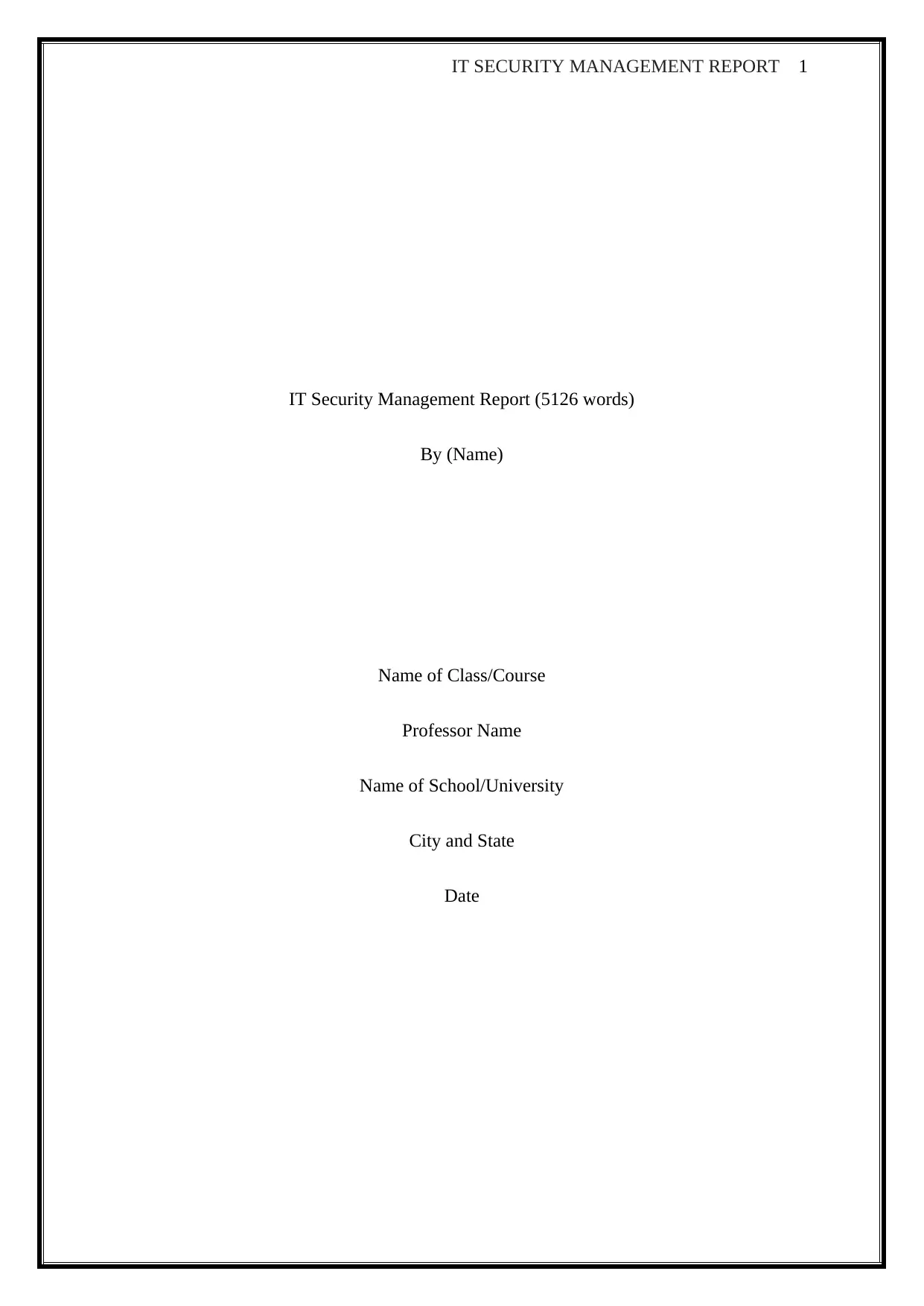
IT SECURITY MANAGEMENT REPORT 1
IT Security Management Report (5126 words)
By (Name)
Name of Class/Course
Professor Name
Name of School/University
City and State
Date
IT Security Management Report (5126 words)
By (Name)
Name of Class/Course
Professor Name
Name of School/University
City and State
Date
Paraphrase This Document
Need a fresh take? Get an instant paraphrase of this document with our AI Paraphraser
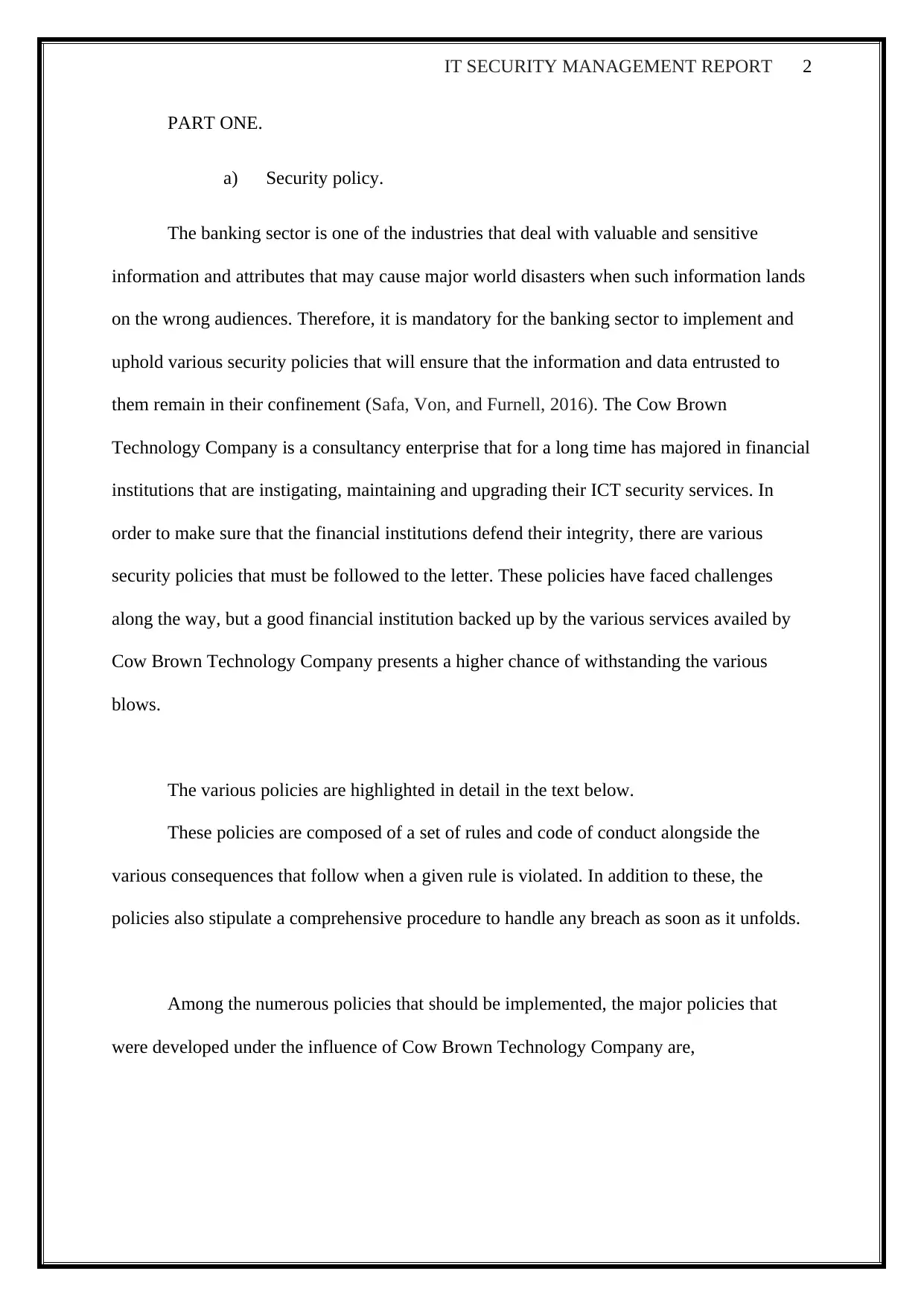
IT SECURITY MANAGEMENT REPORT 2
PART ONE.
a) Security policy.
The banking sector is one of the industries that deal with valuable and sensitive
information and attributes that may cause major world disasters when such information lands
on the wrong audiences. Therefore, it is mandatory for the banking sector to implement and
uphold various security policies that will ensure that the information and data entrusted to
them remain in their confinement (Safa, Von, and Furnell, 2016). The Cow Brown
Technology Company is a consultancy enterprise that for a long time has majored in financial
institutions that are instigating, maintaining and upgrading their ICT security services. In
order to make sure that the financial institutions defend their integrity, there are various
security policies that must be followed to the letter. These policies have faced challenges
along the way, but a good financial institution backed up by the various services availed by
Cow Brown Technology Company presents a higher chance of withstanding the various
blows.
The various policies are highlighted in detail in the text below.
These policies are composed of a set of rules and code of conduct alongside the
various consequences that follow when a given rule is violated. In addition to these, the
policies also stipulate a comprehensive procedure to handle any breach as soon as it unfolds.
Among the numerous policies that should be implemented, the major policies that
were developed under the influence of Cow Brown Technology Company are,
PART ONE.
a) Security policy.
The banking sector is one of the industries that deal with valuable and sensitive
information and attributes that may cause major world disasters when such information lands
on the wrong audiences. Therefore, it is mandatory for the banking sector to implement and
uphold various security policies that will ensure that the information and data entrusted to
them remain in their confinement (Safa, Von, and Furnell, 2016). The Cow Brown
Technology Company is a consultancy enterprise that for a long time has majored in financial
institutions that are instigating, maintaining and upgrading their ICT security services. In
order to make sure that the financial institutions defend their integrity, there are various
security policies that must be followed to the letter. These policies have faced challenges
along the way, but a good financial institution backed up by the various services availed by
Cow Brown Technology Company presents a higher chance of withstanding the various
blows.
The various policies are highlighted in detail in the text below.
These policies are composed of a set of rules and code of conduct alongside the
various consequences that follow when a given rule is violated. In addition to these, the
policies also stipulate a comprehensive procedure to handle any breach as soon as it unfolds.
Among the numerous policies that should be implemented, the major policies that
were developed under the influence of Cow Brown Technology Company are,
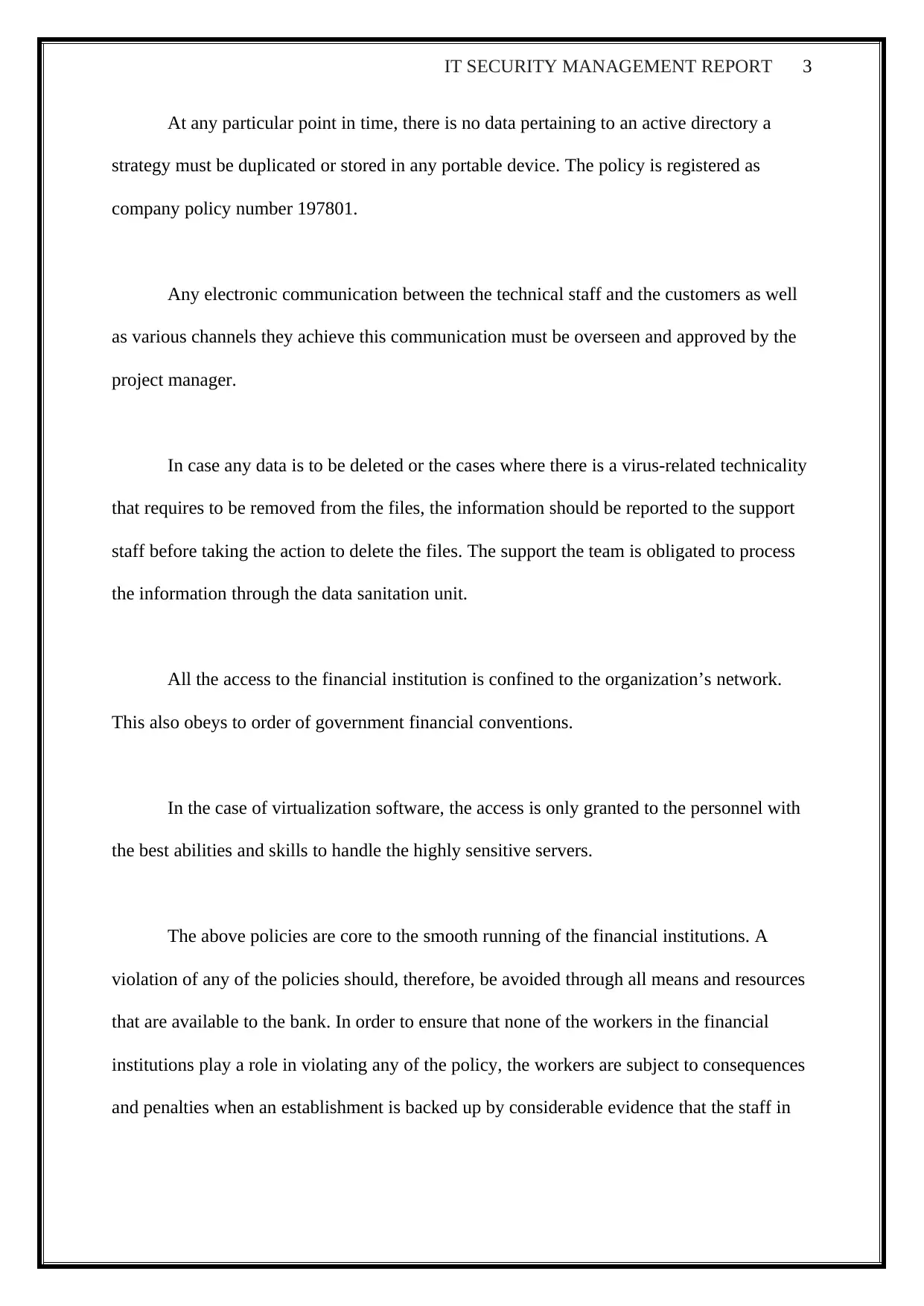
IT SECURITY MANAGEMENT REPORT 3
At any particular point in time, there is no data pertaining to an active directory a
strategy must be duplicated or stored in any portable device. The policy is registered as
company policy number 197801.
Any electronic communication between the technical staff and the customers as well
as various channels they achieve this communication must be overseen and approved by the
project manager.
In case any data is to be deleted or the cases where there is a virus-related technicality
that requires to be removed from the files, the information should be reported to the support
staff before taking the action to delete the files. The support the team is obligated to process
the information through the data sanitation unit.
All the access to the financial institution is confined to the organization’s network.
This also obeys to order of government financial conventions.
In the case of virtualization software, the access is only granted to the personnel with
the best abilities and skills to handle the highly sensitive servers.
The above policies are core to the smooth running of the financial institutions. A
violation of any of the policies should, therefore, be avoided through all means and resources
that are available to the bank. In order to ensure that none of the workers in the financial
institutions play a role in violating any of the policy, the workers are subject to consequences
and penalties when an establishment is backed up by considerable evidence that the staff in
At any particular point in time, there is no data pertaining to an active directory a
strategy must be duplicated or stored in any portable device. The policy is registered as
company policy number 197801.
Any electronic communication between the technical staff and the customers as well
as various channels they achieve this communication must be overseen and approved by the
project manager.
In case any data is to be deleted or the cases where there is a virus-related technicality
that requires to be removed from the files, the information should be reported to the support
staff before taking the action to delete the files. The support the team is obligated to process
the information through the data sanitation unit.
All the access to the financial institution is confined to the organization’s network.
This also obeys to order of government financial conventions.
In the case of virtualization software, the access is only granted to the personnel with
the best abilities and skills to handle the highly sensitive servers.
The above policies are core to the smooth running of the financial institutions. A
violation of any of the policies should, therefore, be avoided through all means and resources
that are available to the bank. In order to ensure that none of the workers in the financial
institutions play a role in violating any of the policy, the workers are subject to consequences
and penalties when an establishment is backed up by considerable evidence that the staff in
⊘ This is a preview!⊘
Do you want full access?
Subscribe today to unlock all pages.

Trusted by 1+ million students worldwide
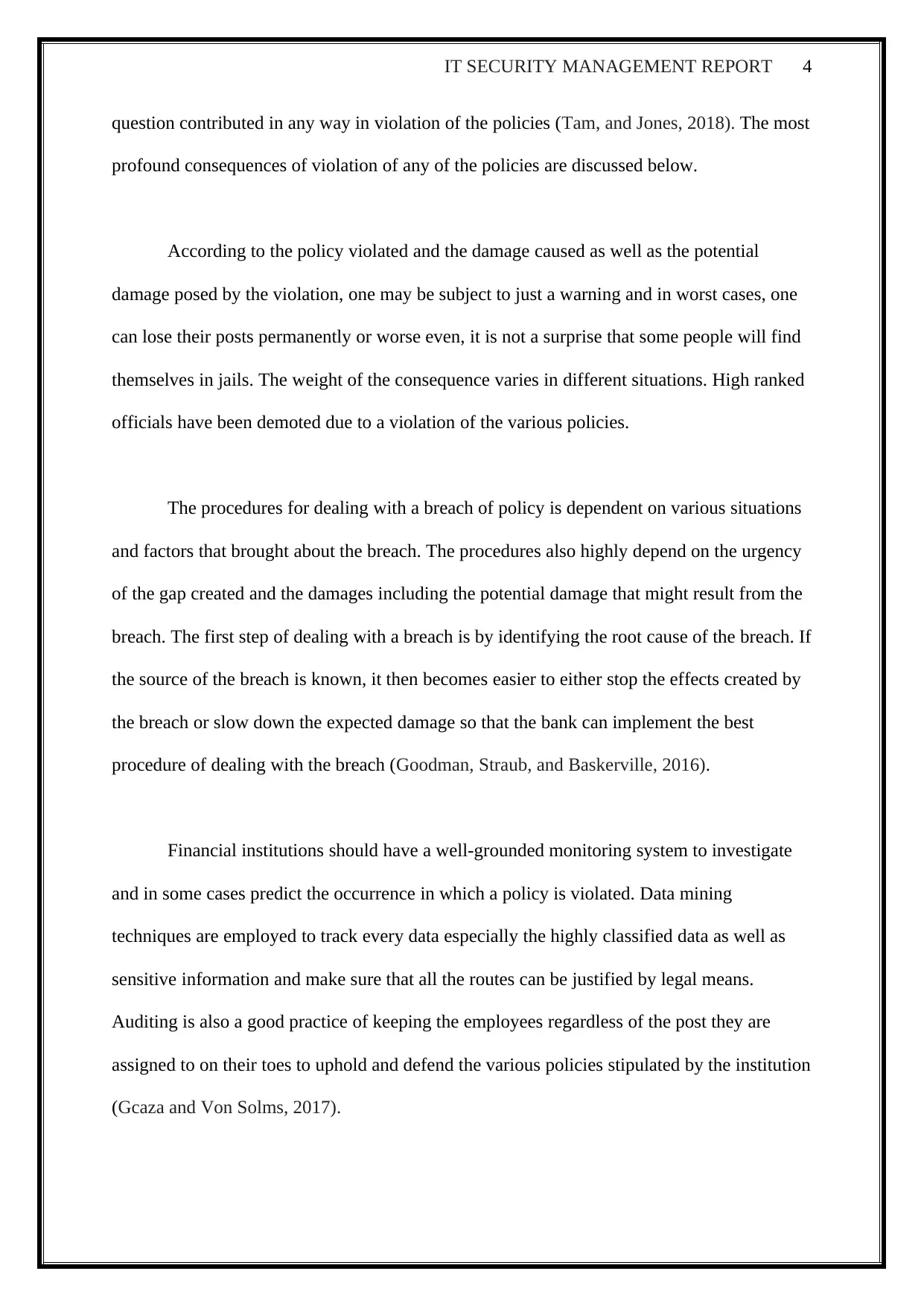
IT SECURITY MANAGEMENT REPORT 4
question contributed in any way in violation of the policies (Tam, and Jones, 2018). The most
profound consequences of violation of any of the policies are discussed below.
According to the policy violated and the damage caused as well as the potential
damage posed by the violation, one may be subject to just a warning and in worst cases, one
can lose their posts permanently or worse even, it is not a surprise that some people will find
themselves in jails. The weight of the consequence varies in different situations. High ranked
officials have been demoted due to a violation of the various policies.
The procedures for dealing with a breach of policy is dependent on various situations
and factors that brought about the breach. The procedures also highly depend on the urgency
of the gap created and the damages including the potential damage that might result from the
breach. The first step of dealing with a breach is by identifying the root cause of the breach. If
the source of the breach is known, it then becomes easier to either stop the effects created by
the breach or slow down the expected damage so that the bank can implement the best
procedure of dealing with the breach (Goodman, Straub, and Baskerville, 2016).
Financial institutions should have a well-grounded monitoring system to investigate
and in some cases predict the occurrence in which a policy is violated. Data mining
techniques are employed to track every data especially the highly classified data as well as
sensitive information and make sure that all the routes can be justified by legal means.
Auditing is also a good practice of keeping the employees regardless of the post they are
assigned to on their toes to uphold and defend the various policies stipulated by the institution
(Gcaza and Von Solms, 2017).
question contributed in any way in violation of the policies (Tam, and Jones, 2018). The most
profound consequences of violation of any of the policies are discussed below.
According to the policy violated and the damage caused as well as the potential
damage posed by the violation, one may be subject to just a warning and in worst cases, one
can lose their posts permanently or worse even, it is not a surprise that some people will find
themselves in jails. The weight of the consequence varies in different situations. High ranked
officials have been demoted due to a violation of the various policies.
The procedures for dealing with a breach of policy is dependent on various situations
and factors that brought about the breach. The procedures also highly depend on the urgency
of the gap created and the damages including the potential damage that might result from the
breach. The first step of dealing with a breach is by identifying the root cause of the breach. If
the source of the breach is known, it then becomes easier to either stop the effects created by
the breach or slow down the expected damage so that the bank can implement the best
procedure of dealing with the breach (Goodman, Straub, and Baskerville, 2016).
Financial institutions should have a well-grounded monitoring system to investigate
and in some cases predict the occurrence in which a policy is violated. Data mining
techniques are employed to track every data especially the highly classified data as well as
sensitive information and make sure that all the routes can be justified by legal means.
Auditing is also a good practice of keeping the employees regardless of the post they are
assigned to on their toes to uphold and defend the various policies stipulated by the institution
(Gcaza and Von Solms, 2017).
Paraphrase This Document
Need a fresh take? Get an instant paraphrase of this document with our AI Paraphraser
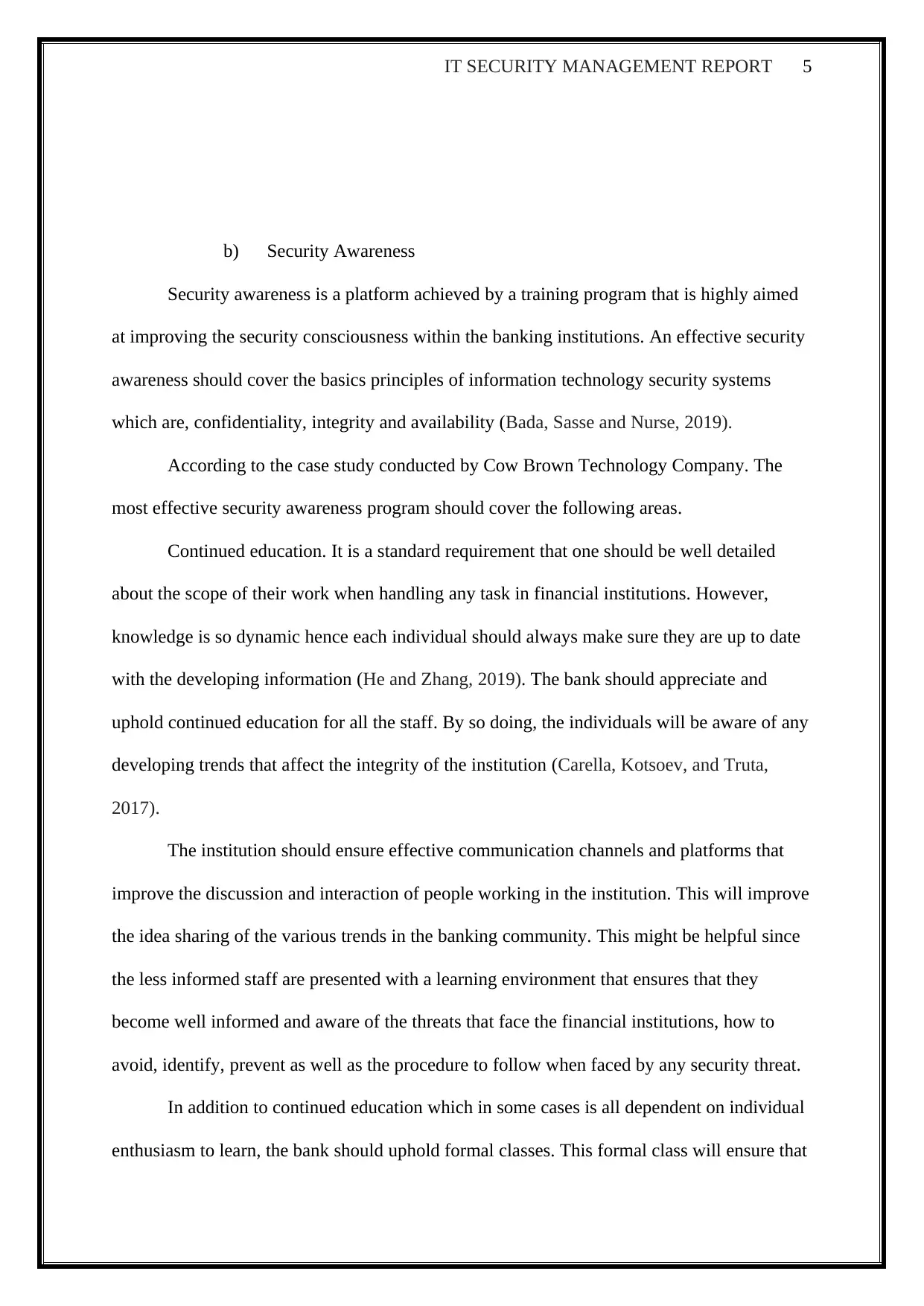
IT SECURITY MANAGEMENT REPORT 5
b) Security Awareness
Security awareness is a platform achieved by a training program that is highly aimed
at improving the security consciousness within the banking institutions. An effective security
awareness should cover the basics principles of information technology security systems
which are, confidentiality, integrity and availability (Bada, Sasse and Nurse, 2019).
According to the case study conducted by Cow Brown Technology Company. The
most effective security awareness program should cover the following areas.
Continued education. It is a standard requirement that one should be well detailed
about the scope of their work when handling any task in financial institutions. However,
knowledge is so dynamic hence each individual should always make sure they are up to date
with the developing information (He and Zhang, 2019). The bank should appreciate and
uphold continued education for all the staff. By so doing, the individuals will be aware of any
developing trends that affect the integrity of the institution (Carella, Kotsoev, and Truta,
2017).
The institution should ensure effective communication channels and platforms that
improve the discussion and interaction of people working in the institution. This will improve
the idea sharing of the various trends in the banking community. This might be helpful since
the less informed staff are presented with a learning environment that ensures that they
become well informed and aware of the threats that face the financial institutions, how to
avoid, identify, prevent as well as the procedure to follow when faced by any security threat.
In addition to continued education which in some cases is all dependent on individual
enthusiasm to learn, the bank should uphold formal classes. This formal class will ensure that
b) Security Awareness
Security awareness is a platform achieved by a training program that is highly aimed
at improving the security consciousness within the banking institutions. An effective security
awareness should cover the basics principles of information technology security systems
which are, confidentiality, integrity and availability (Bada, Sasse and Nurse, 2019).
According to the case study conducted by Cow Brown Technology Company. The
most effective security awareness program should cover the following areas.
Continued education. It is a standard requirement that one should be well detailed
about the scope of their work when handling any task in financial institutions. However,
knowledge is so dynamic hence each individual should always make sure they are up to date
with the developing information (He and Zhang, 2019). The bank should appreciate and
uphold continued education for all the staff. By so doing, the individuals will be aware of any
developing trends that affect the integrity of the institution (Carella, Kotsoev, and Truta,
2017).
The institution should ensure effective communication channels and platforms that
improve the discussion and interaction of people working in the institution. This will improve
the idea sharing of the various trends in the banking community. This might be helpful since
the less informed staff are presented with a learning environment that ensures that they
become well informed and aware of the threats that face the financial institutions, how to
avoid, identify, prevent as well as the procedure to follow when faced by any security threat.
In addition to continued education which in some cases is all dependent on individual
enthusiasm to learn, the bank should uphold formal classes. This formal class will ensure that
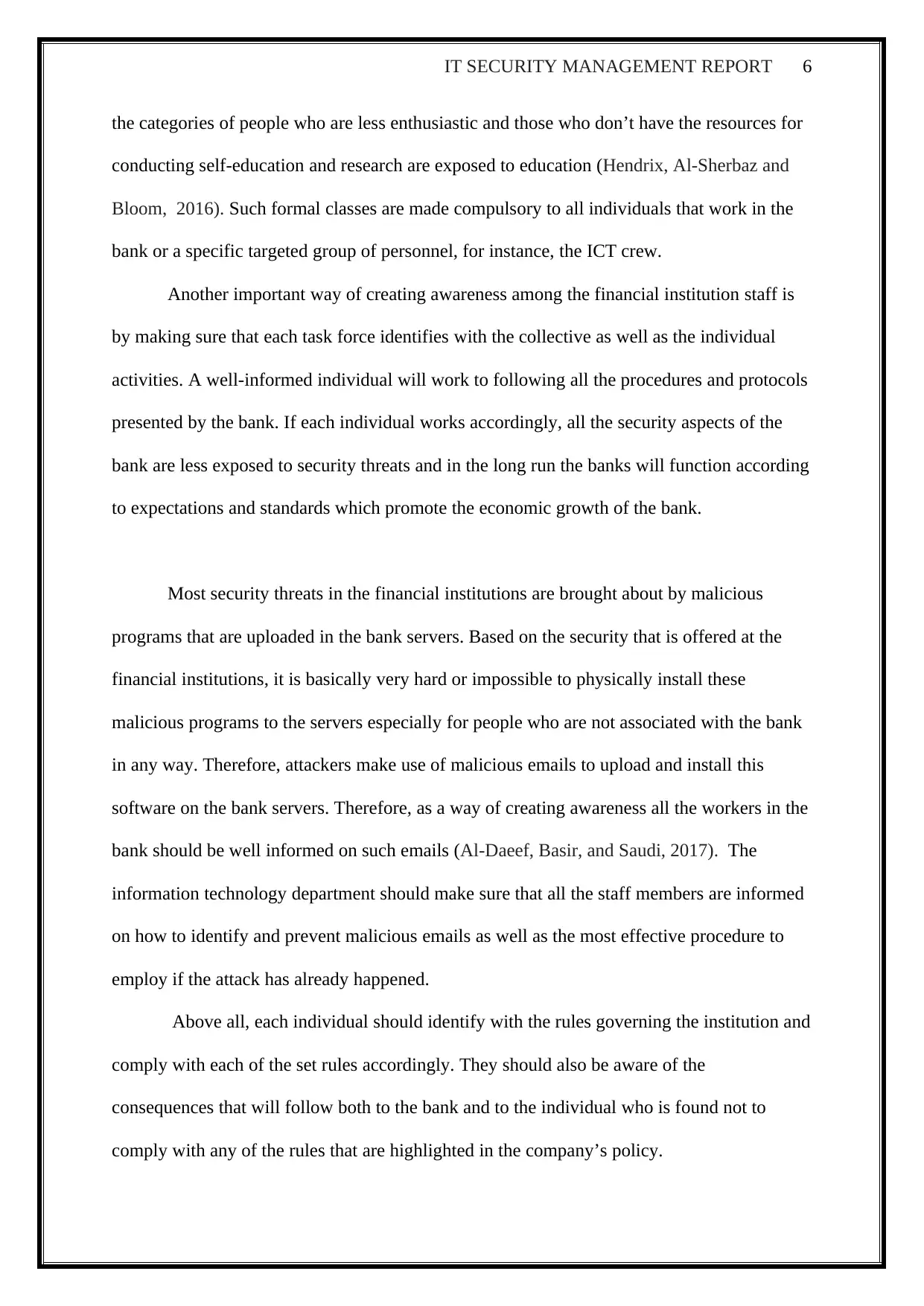
IT SECURITY MANAGEMENT REPORT 6
the categories of people who are less enthusiastic and those who don’t have the resources for
conducting self-education and research are exposed to education (Hendrix, Al-Sherbaz and
Bloom, 2016). Such formal classes are made compulsory to all individuals that work in the
bank or a specific targeted group of personnel, for instance, the ICT crew.
Another important way of creating awareness among the financial institution staff is
by making sure that each task force identifies with the collective as well as the individual
activities. A well-informed individual will work to following all the procedures and protocols
presented by the bank. If each individual works accordingly, all the security aspects of the
bank are less exposed to security threats and in the long run the banks will function according
to expectations and standards which promote the economic growth of the bank.
Most security threats in the financial institutions are brought about by malicious
programs that are uploaded in the bank servers. Based on the security that is offered at the
financial institutions, it is basically very hard or impossible to physically install these
malicious programs to the servers especially for people who are not associated with the bank
in any way. Therefore, attackers make use of malicious emails to upload and install this
software on the bank servers. Therefore, as a way of creating awareness all the workers in the
bank should be well informed on such emails (Al-Daeef, Basir, and Saudi, 2017). The
information technology department should make sure that all the staff members are informed
on how to identify and prevent malicious emails as well as the most effective procedure to
employ if the attack has already happened.
Above all, each individual should identify with the rules governing the institution and
comply with each of the set rules accordingly. They should also be aware of the
consequences that will follow both to the bank and to the individual who is found not to
comply with any of the rules that are highlighted in the company’s policy.
the categories of people who are less enthusiastic and those who don’t have the resources for
conducting self-education and research are exposed to education (Hendrix, Al-Sherbaz and
Bloom, 2016). Such formal classes are made compulsory to all individuals that work in the
bank or a specific targeted group of personnel, for instance, the ICT crew.
Another important way of creating awareness among the financial institution staff is
by making sure that each task force identifies with the collective as well as the individual
activities. A well-informed individual will work to following all the procedures and protocols
presented by the bank. If each individual works accordingly, all the security aspects of the
bank are less exposed to security threats and in the long run the banks will function according
to expectations and standards which promote the economic growth of the bank.
Most security threats in the financial institutions are brought about by malicious
programs that are uploaded in the bank servers. Based on the security that is offered at the
financial institutions, it is basically very hard or impossible to physically install these
malicious programs to the servers especially for people who are not associated with the bank
in any way. Therefore, attackers make use of malicious emails to upload and install this
software on the bank servers. Therefore, as a way of creating awareness all the workers in the
bank should be well informed on such emails (Al-Daeef, Basir, and Saudi, 2017). The
information technology department should make sure that all the staff members are informed
on how to identify and prevent malicious emails as well as the most effective procedure to
employ if the attack has already happened.
Above all, each individual should identify with the rules governing the institution and
comply with each of the set rules accordingly. They should also be aware of the
consequences that will follow both to the bank and to the individual who is found not to
comply with any of the rules that are highlighted in the company’s policy.
⊘ This is a preview!⊘
Do you want full access?
Subscribe today to unlock all pages.

Trusted by 1+ million students worldwide
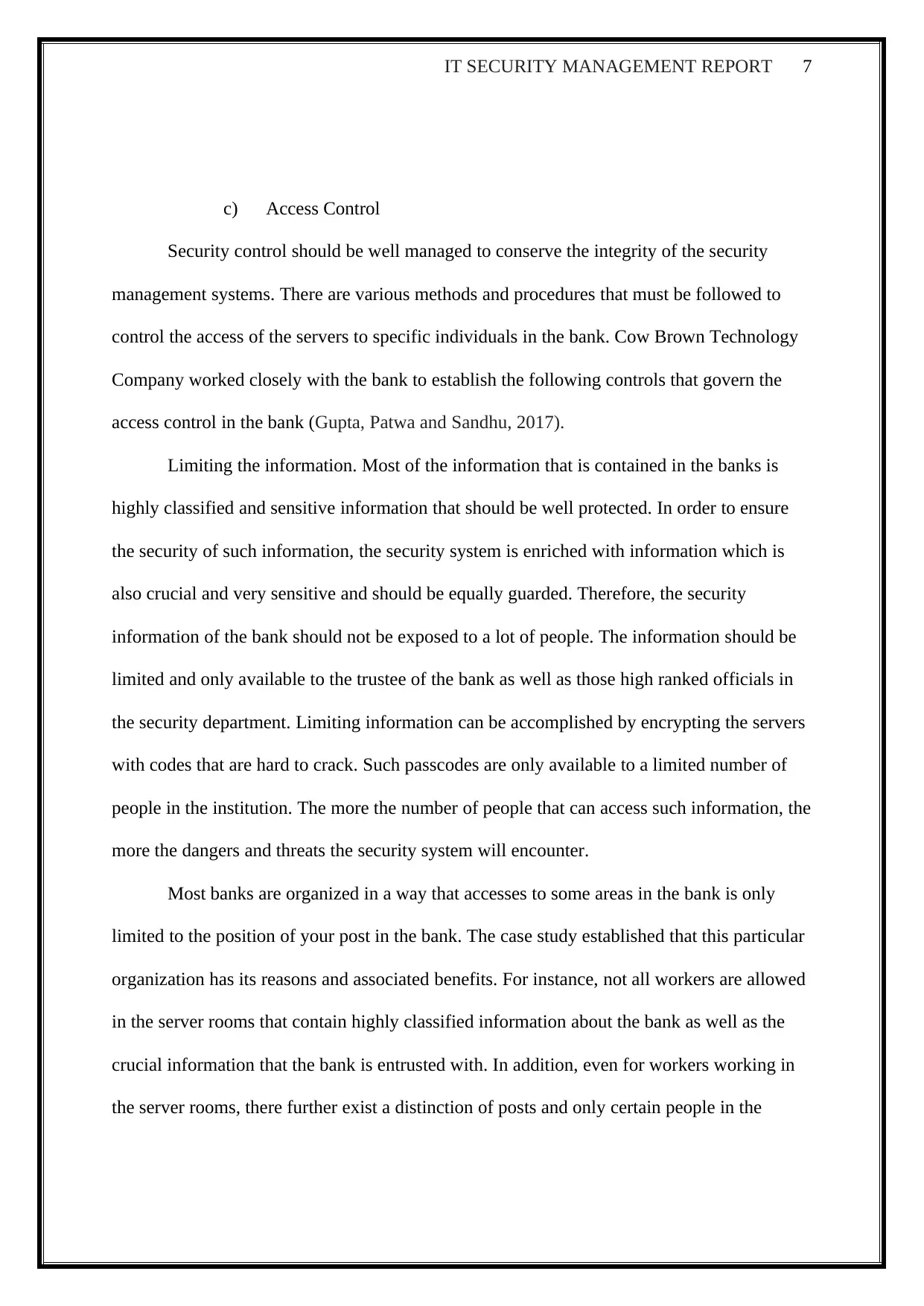
IT SECURITY MANAGEMENT REPORT 7
c) Access Control
Security control should be well managed to conserve the integrity of the security
management systems. There are various methods and procedures that must be followed to
control the access of the servers to specific individuals in the bank. Cow Brown Technology
Company worked closely with the bank to establish the following controls that govern the
access control in the bank (Gupta, Patwa and Sandhu, 2017).
Limiting the information. Most of the information that is contained in the banks is
highly classified and sensitive information that should be well protected. In order to ensure
the security of such information, the security system is enriched with information which is
also crucial and very sensitive and should be equally guarded. Therefore, the security
information of the bank should not be exposed to a lot of people. The information should be
limited and only available to the trustee of the bank as well as those high ranked officials in
the security department. Limiting information can be accomplished by encrypting the servers
with codes that are hard to crack. Such passcodes are only available to a limited number of
people in the institution. The more the number of people that can access such information, the
more the dangers and threats the security system will encounter.
Most banks are organized in a way that accesses to some areas in the bank is only
limited to the position of your post in the bank. The case study established that this particular
organization has its reasons and associated benefits. For instance, not all workers are allowed
in the server rooms that contain highly classified information about the bank as well as the
crucial information that the bank is entrusted with. In addition, even for workers working in
the server rooms, there further exist a distinction of posts and only certain people in the
c) Access Control
Security control should be well managed to conserve the integrity of the security
management systems. There are various methods and procedures that must be followed to
control the access of the servers to specific individuals in the bank. Cow Brown Technology
Company worked closely with the bank to establish the following controls that govern the
access control in the bank (Gupta, Patwa and Sandhu, 2017).
Limiting the information. Most of the information that is contained in the banks is
highly classified and sensitive information that should be well protected. In order to ensure
the security of such information, the security system is enriched with information which is
also crucial and very sensitive and should be equally guarded. Therefore, the security
information of the bank should not be exposed to a lot of people. The information should be
limited and only available to the trustee of the bank as well as those high ranked officials in
the security department. Limiting information can be accomplished by encrypting the servers
with codes that are hard to crack. Such passcodes are only available to a limited number of
people in the institution. The more the number of people that can access such information, the
more the dangers and threats the security system will encounter.
Most banks are organized in a way that accesses to some areas in the bank is only
limited to the position of your post in the bank. The case study established that this particular
organization has its reasons and associated benefits. For instance, not all workers are allowed
in the server rooms that contain highly classified information about the bank as well as the
crucial information that the bank is entrusted with. In addition, even for workers working in
the server rooms, there further exist a distinction of posts and only certain people in the
Paraphrase This Document
Need a fresh take? Get an instant paraphrase of this document with our AI Paraphraser
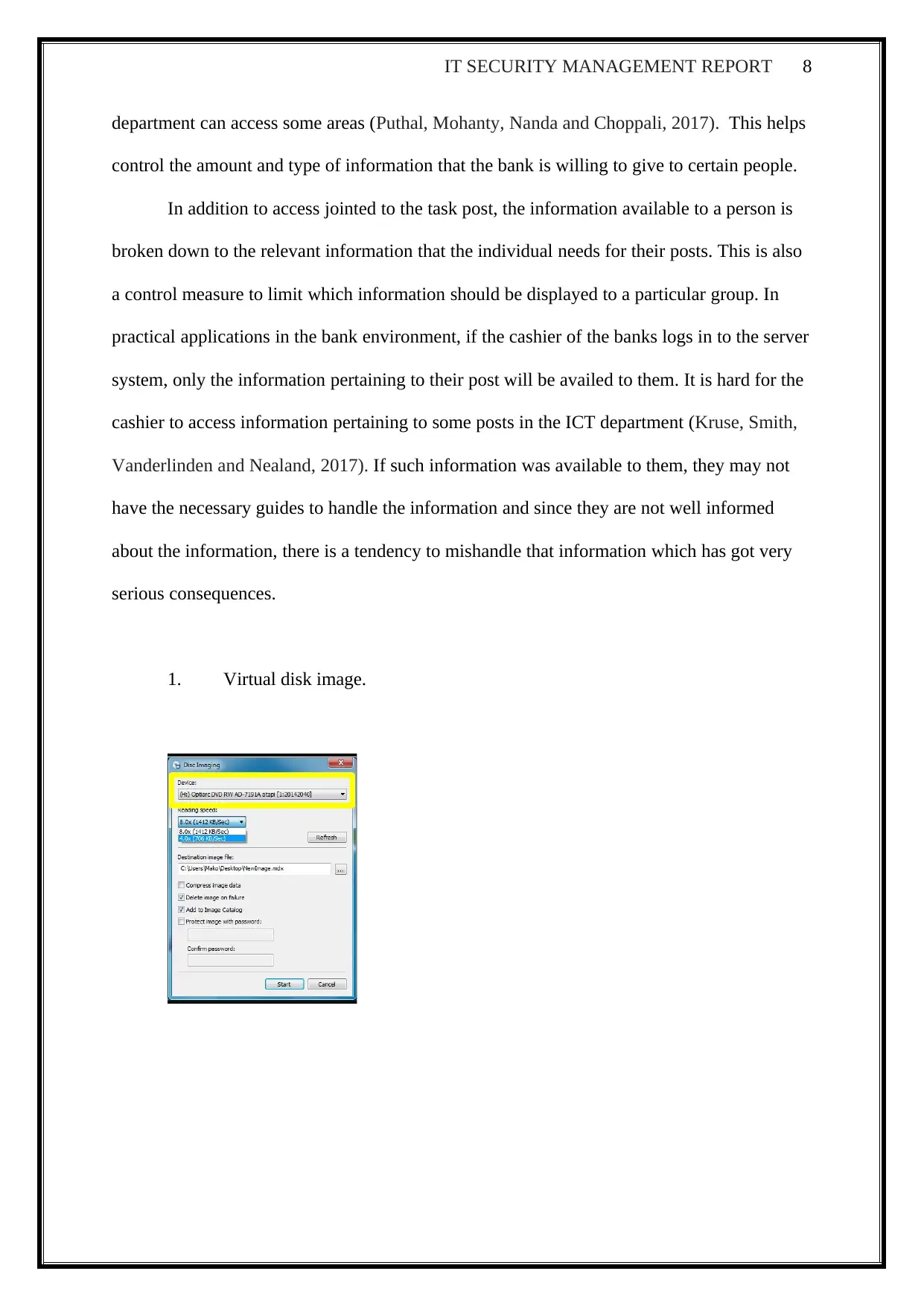
IT SECURITY MANAGEMENT REPORT 8
department can access some areas (Puthal, Mohanty, Nanda and Choppali, 2017). This helps
control the amount and type of information that the bank is willing to give to certain people.
In addition to access jointed to the task post, the information available to a person is
broken down to the relevant information that the individual needs for their posts. This is also
a control measure to limit which information should be displayed to a particular group. In
practical applications in the bank environment, if the cashier of the banks logs in to the server
system, only the information pertaining to their post will be availed to them. It is hard for the
cashier to access information pertaining to some posts in the ICT department (Kruse, Smith,
Vanderlinden and Nealand, 2017). If such information was available to them, they may not
have the necessary guides to handle the information and since they are not well informed
about the information, there is a tendency to mishandle that information which has got very
serious consequences.
1. Virtual disk image.
department can access some areas (Puthal, Mohanty, Nanda and Choppali, 2017). This helps
control the amount and type of information that the bank is willing to give to certain people.
In addition to access jointed to the task post, the information available to a person is
broken down to the relevant information that the individual needs for their posts. This is also
a control measure to limit which information should be displayed to a particular group. In
practical applications in the bank environment, if the cashier of the banks logs in to the server
system, only the information pertaining to their post will be availed to them. It is hard for the
cashier to access information pertaining to some posts in the ICT department (Kruse, Smith,
Vanderlinden and Nealand, 2017). If such information was available to them, they may not
have the necessary guides to handle the information and since they are not well informed
about the information, there is a tendency to mishandle that information which has got very
serious consequences.
1. Virtual disk image.
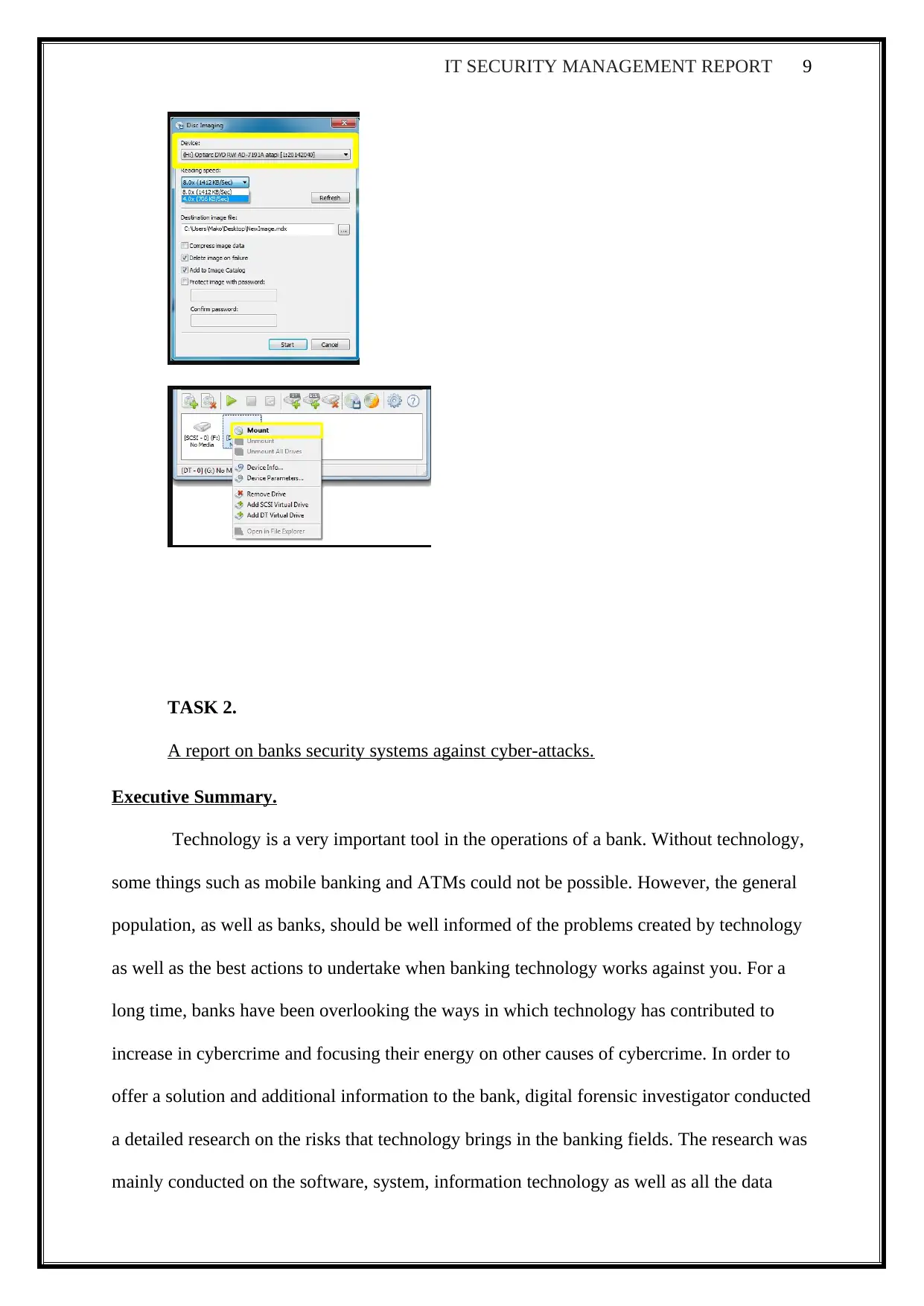
IT SECURITY MANAGEMENT REPORT 9
TASK 2.
A report on banks security systems against cyber-attacks.
Executive Summary.
Technology is a very important tool in the operations of a bank. Without technology,
some things such as mobile banking and ATMs could not be possible. However, the general
population, as well as banks, should be well informed of the problems created by technology
as well as the best actions to undertake when banking technology works against you. For a
long time, banks have been overlooking the ways in which technology has contributed to
increase in cybercrime and focusing their energy on other causes of cybercrime. In order to
offer a solution and additional information to the bank, digital forensic investigator conducted
a detailed research on the risks that technology brings in the banking fields. The research was
mainly conducted on the software, system, information technology as well as all the data
TASK 2.
A report on banks security systems against cyber-attacks.
Executive Summary.
Technology is a very important tool in the operations of a bank. Without technology,
some things such as mobile banking and ATMs could not be possible. However, the general
population, as well as banks, should be well informed of the problems created by technology
as well as the best actions to undertake when banking technology works against you. For a
long time, banks have been overlooking the ways in which technology has contributed to
increase in cybercrime and focusing their energy on other causes of cybercrime. In order to
offer a solution and additional information to the bank, digital forensic investigator conducted
a detailed research on the risks that technology brings in the banking fields. The research was
mainly conducted on the software, system, information technology as well as all the data
⊘ This is a preview!⊘
Do you want full access?
Subscribe today to unlock all pages.

Trusted by 1+ million students worldwide
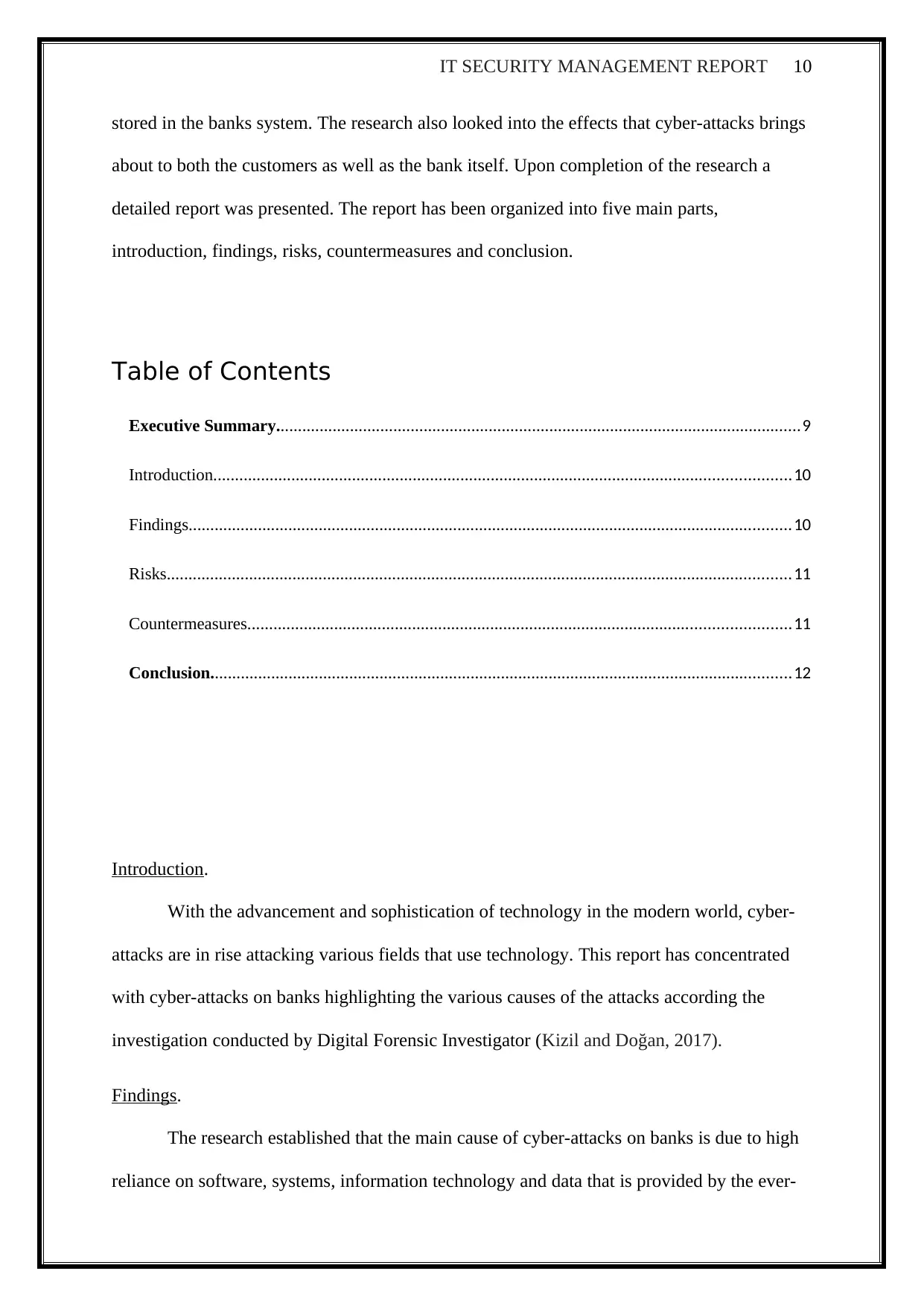
IT SECURITY MANAGEMENT REPORT 10
stored in the banks system. The research also looked into the effects that cyber-attacks brings
about to both the customers as well as the bank itself. Upon completion of the research a
detailed report was presented. The report has been organized into five main parts,
introduction, findings, risks, countermeasures and conclusion.
Table of Contents
Executive Summary.........................................................................................................................9
Introduction.....................................................................................................................................10
Findings...........................................................................................................................................10
Risks................................................................................................................................................11
Countermeasures.............................................................................................................................11
Conclusion......................................................................................................................................12
Introduction.
With the advancement and sophistication of technology in the modern world, cyber-
attacks are in rise attacking various fields that use technology. This report has concentrated
with cyber-attacks on banks highlighting the various causes of the attacks according the
investigation conducted by Digital Forensic Investigator (Kizil and Doğan, 2017).
Findings.
The research established that the main cause of cyber-attacks on banks is due to high
reliance on software, systems, information technology and data that is provided by the ever-
stored in the banks system. The research also looked into the effects that cyber-attacks brings
about to both the customers as well as the bank itself. Upon completion of the research a
detailed report was presented. The report has been organized into five main parts,
introduction, findings, risks, countermeasures and conclusion.
Table of Contents
Executive Summary.........................................................................................................................9
Introduction.....................................................................................................................................10
Findings...........................................................................................................................................10
Risks................................................................................................................................................11
Countermeasures.............................................................................................................................11
Conclusion......................................................................................................................................12
Introduction.
With the advancement and sophistication of technology in the modern world, cyber-
attacks are in rise attacking various fields that use technology. This report has concentrated
with cyber-attacks on banks highlighting the various causes of the attacks according the
investigation conducted by Digital Forensic Investigator (Kizil and Doğan, 2017).
Findings.
The research established that the main cause of cyber-attacks on banks is due to high
reliance on software, systems, information technology and data that is provided by the ever-
Paraphrase This Document
Need a fresh take? Get an instant paraphrase of this document with our AI Paraphraser
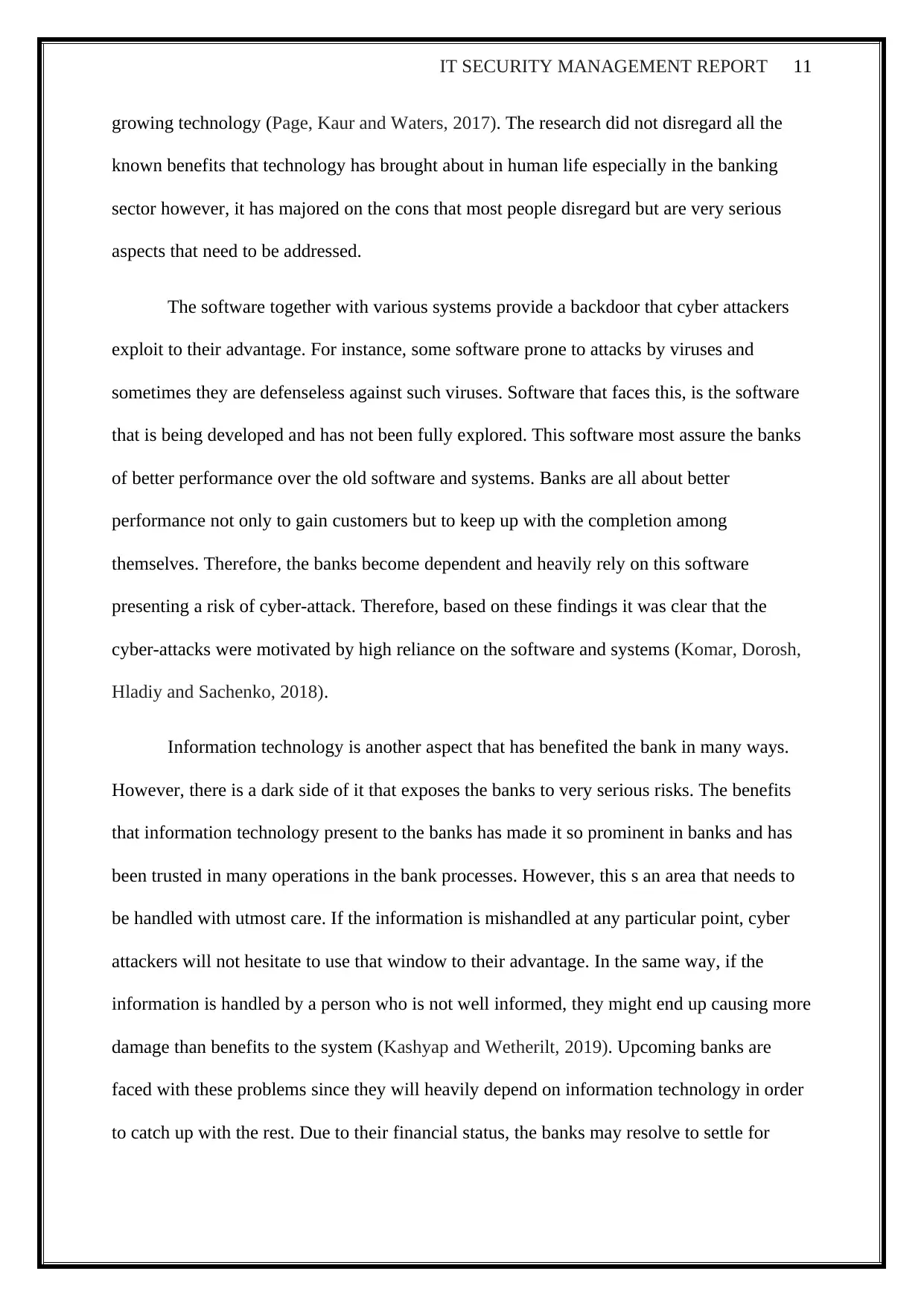
IT SECURITY MANAGEMENT REPORT 11
growing technology (Page, Kaur and Waters, 2017). The research did not disregard all the
known benefits that technology has brought about in human life especially in the banking
sector however, it has majored on the cons that most people disregard but are very serious
aspects that need to be addressed.
The software together with various systems provide a backdoor that cyber attackers
exploit to their advantage. For instance, some software prone to attacks by viruses and
sometimes they are defenseless against such viruses. Software that faces this, is the software
that is being developed and has not been fully explored. This software most assure the banks
of better performance over the old software and systems. Banks are all about better
performance not only to gain customers but to keep up with the completion among
themselves. Therefore, the banks become dependent and heavily rely on this software
presenting a risk of cyber-attack. Therefore, based on these findings it was clear that the
cyber-attacks were motivated by high reliance on the software and systems (Komar, Dorosh,
Hladiy and Sachenko, 2018).
Information technology is another aspect that has benefited the bank in many ways.
However, there is a dark side of it that exposes the banks to very serious risks. The benefits
that information technology present to the banks has made it so prominent in banks and has
been trusted in many operations in the bank processes. However, this s an area that needs to
be handled with utmost care. If the information is mishandled at any particular point, cyber
attackers will not hesitate to use that window to their advantage. In the same way, if the
information is handled by a person who is not well informed, they might end up causing more
damage than benefits to the system (Kashyap and Wetherilt, 2019). Upcoming banks are
faced with these problems since they will heavily depend on information technology in order
to catch up with the rest. Due to their financial status, the banks may resolve to settle for
growing technology (Page, Kaur and Waters, 2017). The research did not disregard all the
known benefits that technology has brought about in human life especially in the banking
sector however, it has majored on the cons that most people disregard but are very serious
aspects that need to be addressed.
The software together with various systems provide a backdoor that cyber attackers
exploit to their advantage. For instance, some software prone to attacks by viruses and
sometimes they are defenseless against such viruses. Software that faces this, is the software
that is being developed and has not been fully explored. This software most assure the banks
of better performance over the old software and systems. Banks are all about better
performance not only to gain customers but to keep up with the completion among
themselves. Therefore, the banks become dependent and heavily rely on this software
presenting a risk of cyber-attack. Therefore, based on these findings it was clear that the
cyber-attacks were motivated by high reliance on the software and systems (Komar, Dorosh,
Hladiy and Sachenko, 2018).
Information technology is another aspect that has benefited the bank in many ways.
However, there is a dark side of it that exposes the banks to very serious risks. The benefits
that information technology present to the banks has made it so prominent in banks and has
been trusted in many operations in the bank processes. However, this s an area that needs to
be handled with utmost care. If the information is mishandled at any particular point, cyber
attackers will not hesitate to use that window to their advantage. In the same way, if the
information is handled by a person who is not well informed, they might end up causing more
damage than benefits to the system (Kashyap and Wetherilt, 2019). Upcoming banks are
faced with these problems since they will heavily depend on information technology in order
to catch up with the rest. Due to their financial status, the banks may resolve to settle for
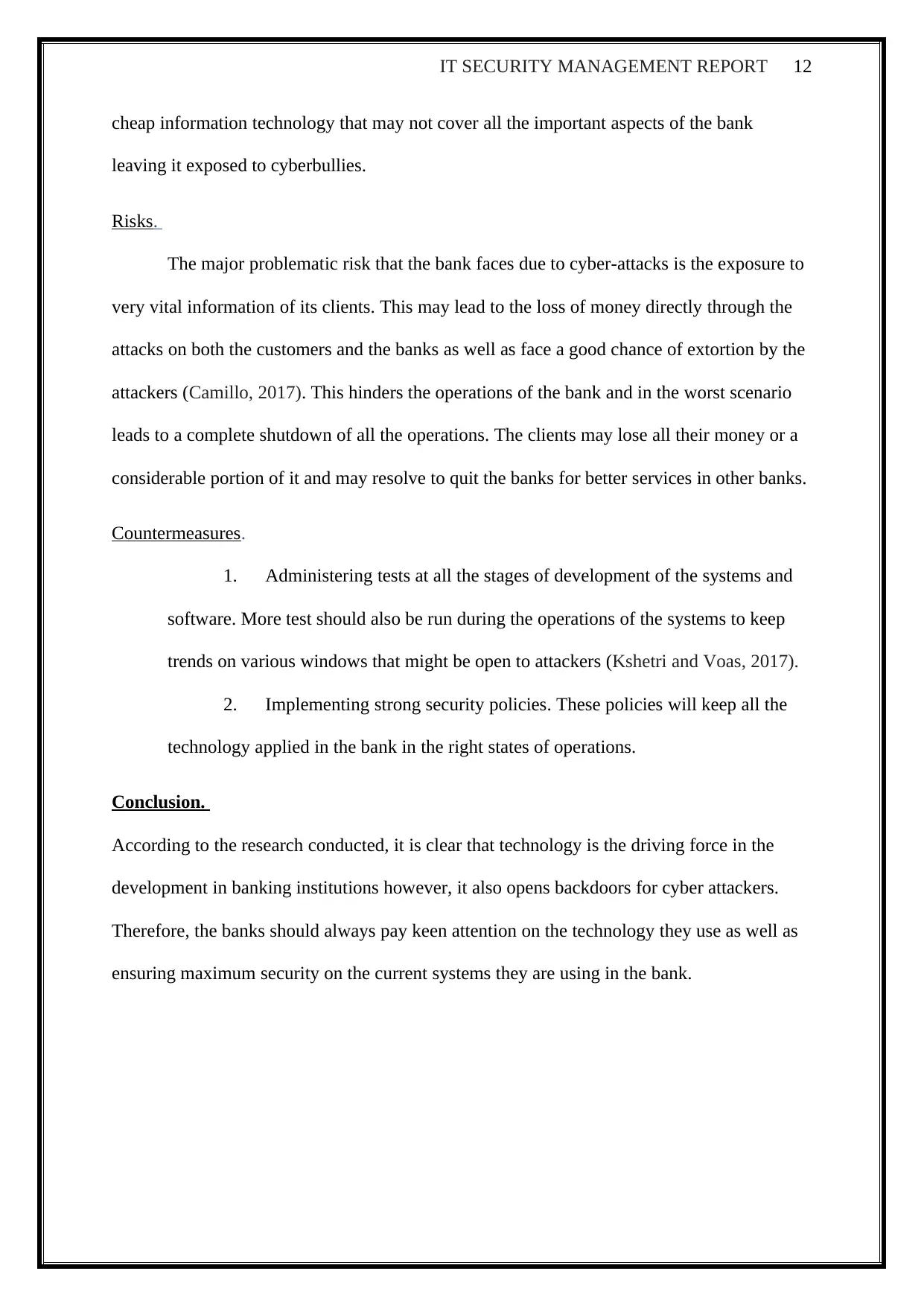
IT SECURITY MANAGEMENT REPORT 12
cheap information technology that may not cover all the important aspects of the bank
leaving it exposed to cyberbullies.
Risks.
The major problematic risk that the bank faces due to cyber-attacks is the exposure to
very vital information of its clients. This may lead to the loss of money directly through the
attacks on both the customers and the banks as well as face a good chance of extortion by the
attackers (Camillo, 2017). This hinders the operations of the bank and in the worst scenario
leads to a complete shutdown of all the operations. The clients may lose all their money or a
considerable portion of it and may resolve to quit the banks for better services in other banks.
Countermeasures.
1. Administering tests at all the stages of development of the systems and
software. More test should also be run during the operations of the systems to keep
trends on various windows that might be open to attackers (Kshetri and Voas, 2017).
2. Implementing strong security policies. These policies will keep all the
technology applied in the bank in the right states of operations.
Conclusion.
According to the research conducted, it is clear that technology is the driving force in the
development in banking institutions however, it also opens backdoors for cyber attackers.
Therefore, the banks should always pay keen attention on the technology they use as well as
ensuring maximum security on the current systems they are using in the bank.
cheap information technology that may not cover all the important aspects of the bank
leaving it exposed to cyberbullies.
Risks.
The major problematic risk that the bank faces due to cyber-attacks is the exposure to
very vital information of its clients. This may lead to the loss of money directly through the
attacks on both the customers and the banks as well as face a good chance of extortion by the
attackers (Camillo, 2017). This hinders the operations of the bank and in the worst scenario
leads to a complete shutdown of all the operations. The clients may lose all their money or a
considerable portion of it and may resolve to quit the banks for better services in other banks.
Countermeasures.
1. Administering tests at all the stages of development of the systems and
software. More test should also be run during the operations of the systems to keep
trends on various windows that might be open to attackers (Kshetri and Voas, 2017).
2. Implementing strong security policies. These policies will keep all the
technology applied in the bank in the right states of operations.
Conclusion.
According to the research conducted, it is clear that technology is the driving force in the
development in banking institutions however, it also opens backdoors for cyber attackers.
Therefore, the banks should always pay keen attention on the technology they use as well as
ensuring maximum security on the current systems they are using in the bank.
⊘ This is a preview!⊘
Do you want full access?
Subscribe today to unlock all pages.

Trusted by 1+ million students worldwide
1 out of 28
Related Documents
Your All-in-One AI-Powered Toolkit for Academic Success.
+13062052269
info@desklib.com
Available 24*7 on WhatsApp / Email
![[object Object]](/_next/static/media/star-bottom.7253800d.svg)
Unlock your academic potential
Copyright © 2020–2025 A2Z Services. All Rights Reserved. Developed and managed by ZUCOL.




